1Simon Fraser University, Geography Department, Burnaby, British Columbia, Canada. Email: vblouin@sfu.ca
2Simon Fraser University, Geography Department, Burnaby, British Columbia, Canada.
3Research Branch, BC Ministry of Forests, Kalamalka Forestry Centre, Vernon, British Columbia, Canada.
4University of British Columbia, Faculty of Agricultural Sciences, Vancouver, British Columbia, Canada.
Increased mechanization during timber harvesting activities has led to concerns that compaction may negatively affect the long-term productivity of soil. A greenhouse study was carried out to determine the effects of soil compaction under three levels of soil water content. Mineral soil was collected from a landing in central British Columbia, Canada and lodgepole pine (Pinus contorta Dougl. ex Loud. var. latifolia Engelm.) seedlings were grown in pots for 12 weeks. Pots were compacted to densities that corresponded to 67, 72 and 76% of the Proctor maximum bulk density (1798 kg m-3) for the soil. Volumetric water contents of 0.10-0.15, 0.20-0.30 and 0.30-0.35 cm3cm-3 were maintained by weighing the pots, determining the gravimetric water content and adding the required water. Compaction only had an effect on seedling growth at low water content. Diameter growth and total shoot biomass were significantly smaller for 76% compaction compared to 67% compaction. At low water content, 76% and 72% compaction caused decreases in new root biomass and 76% compaction increased shoot macronutrient concentrations. The findings of this study imply that, for the compaction levels observed, water content had a greater impact on seedling growth than compaction.
Keywords
Compaction, water content, biomass, bulk density, pine seedling, greenhouse
Introduction
Excessive soil disturbance by timber harvesting machinery can lead to a decrease in long-term site productivity. The degree to which heavy machinery degrades the soil is dependent on factors such as the type and season of harvesting practices, site topography, soil type and texture, and soil water content (Ellies et al. 1999; Ahuja et al. 1998; Zabowski et al. 1996). Soil compaction from heavy machinery is not always apparent immediately after harvest and may be overlooked until it is too late to mitigate. In addition, soils may remain compacted for at least a decade (Corns 1988) and a complete harvest rotation may be considered a reasonable time lapse for heavily compacted areas such as skid trails to recover to normal densities (Froehlich 1988).
Effects of soil disturbance
Increased soil strength and limited aeration are likely to be the two main physical factors that affect plant growth in compacted soils (Froehlich and McNabb 1984; Conlin and van den Driessche 2000). Mechanical impedence decreases the rate of plant cell division and reduces the cell length in the root meristem (Bengough and Mullins 1990). Consequently the rate of cell elongation declines (Bengough and Mullins 1990). Compaction affects the pore size distribution and water retention of the soil (Startsev and McNabb 2001). The increased proportion of smaller pores during compaction results in the soil behaving as though it were a finer textured soil (Greacen and Sands 1980). Available soil water also declines when the void volume is decreased (Rockich et al. 2001). When this occurs, nutrients and water may become limited because the plant’s demands exceed the ability of the roots system to access these resources (Froehlich and McNabb 1984). Nutrient deficiencies may seriously limit plant growth in compacted soils since nutrients have limited mobility in soil (Unger and Kaspar 1994).
Soil conservation information needs in British Columbia
In 1994, the provincial government of British Columbia, in response to concerns about the impact of forest management on the environment, brought the Forest Practices Code Act (The Code) into legislation to regulate a wide range of forestry practices. The Code provided comprehensive regulations that limited the amount of soil disturbance on harvested areas, including dispersed disturbance related to logging equipment, and access structures (roads and landings). Permanent access structures were generally limited to 7% or less of the harvest area. Temporary access structures (including roads, landing and trails that were not required for future management of the area) were required to be rehabilitated to restore the productivity of the soil (BC Ministry of Forests 2001). The Code also cited guidebooks that described procedures for identifying sensitive soils and for carrying out surveys to determine the extent to which soil conservation guidelines were achieved.
Efforts to improve the sustainability of BC’s forest sector continued, and on January 31, 2004 the provincial government implemented the Forest and Range Practices Act, which replaces the Forest Practices Code Act after a two year transition period. This new Act maintains environmental standards brought in by the Forest Practices Code, but focuses on achieving them through results-based management, where forestry companies are more accountable for forest stewardship, and there is a greater reliance on licensed professionals to identify appropriate practices to achieve sustainability. The new approach contrasts with the previous regime, where guidebooks that were cited in regulation described many of the recommended practices and procedures. Considering the wide diversity of site types, management regimes, and operational situations in BC forestry, the Forest and Range Practices Act provides more flexibility for forest companies to decide the best method for achieving optimal results.
Despite changes in legislation, the need for information on soil conservation is greater than ever, and in 2001, the Forest Investment Account (FIA) replaced FRBC as a mechanism to provide research funding under BC’s Forest Science Program. Research projects must demonstrate that the information generated will improve forest management in BC. The present study was part of an ongoing, province-wide effort to identify soil conditions that are consistent with productive forest growth on disturbed and undisturbed soils in a wide variety of ecosystems.
Methods
Soil
Mineral soil was collected to a depth of 30 cm near a landing at 52° 19’ 25” N, 122° 5’ 28” W in the Sub-Boreal Spruce (SBS) biogeoclimatic zone of central British Columbia, Canada (Figure 1). The landings were constructed in 1978-1979 to serve as the base for timber harvesting operations such as the delimbing of trees and loading of logs onto trucks. The soil of this landing was virtually free of coarse fragments, had no forest floor development and was low in organic matter content. The landing soil was passed through a 2 cm sieve to remove any coarse fragments and thoroughly mixed to homogenize the soil. The maximum bulk density achieved through Proctor analysis (Proctor 1933) was 1798 kg m-3 (American Society for Testing Materials, Designation D 698-00a. 2000). Particle size analysis by the hydrometer method (Kalra and Maynard 1991) showed that the soil consisted of 28% sand, 46 % silt, and 26% clay.
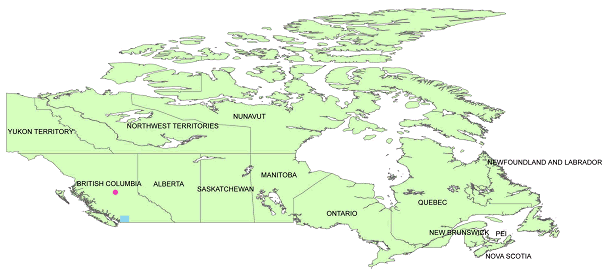
Figure 1. Map of Canada showing the site of mineral soil collection from central British Columbia (represented by the dot) and the site of the greenhouse experiment (represented by the square).
Experimental design
Soil was placed into 7.5 L nursery pots with a height and diameter of 22 cm. It was compacted to three different bulk densities: 67% of maximum bulk density (low compaction), 72% of maximum bulk density (medium compaction), and 76% of maximum bulk density (high compaction), producing bulk densities ranging from 1205 to 1366 kg m-3. This range in bulk densities was based on bulk densities obtained from a field study on the same soil type that examined the variation in bulk densities on compacted and non-compacted areas of forest. The soil had a water content of 0.15 cm3 cm-3 when it was compacted in three portions with a standard compaction hammer, to ensure uniform bulk density (Figure 2). The compaction hammer was dropped from a height of 40 cm and weighed 2.5 kg.
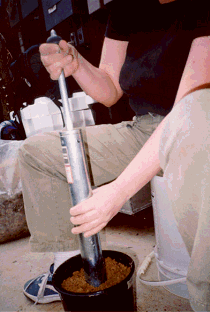
Figure 2. Compaction of soil in nursery pots using a standard compaction hammer.
Each level of compaction was wet to three different water contents. The nine treatments were replicated 15 times for a total of 135 pots. The low water content level was maintained at 0.10-0.15 cm3 cm-3, the medium was 0.20-0.30 cm3 cm-3 and the high water content was 0.30-0.35 cm3 cm-3. Water contents were maintained by weighing each of the pots three times a week on a scale to determine the gravimetric water content. In addition water contents were monitored with a ThetaProbe (model ML2; Delta-T Devices 1999) on a weekly basis (Figure 3).
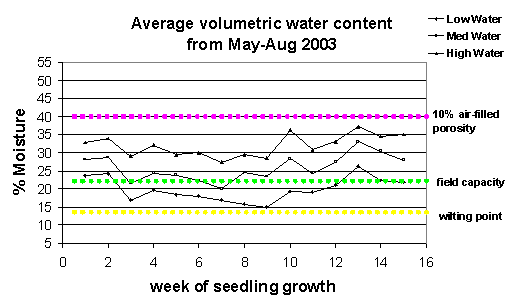
Figure 3. Weekly measurements of volumetric water contents for the low, medium and high water content treatments over all compaction levels.
A lodepole pine (Pinus contorta Dougl. Ex. Loud. var. latifolia Engelm.) seedling was planted into each pot and grown for approximately 12 weeks during the summer in a greenhouse at Simon Fraser University at 49˚ 16’ 47” N, 122˚ 55’ 3” W. At the end of the experiment, shoots and roots of plants were harvested simultaneously. Stem height and stem diameter were measured immediately after harvest with a ruler and calipers, respectively. Soil was carefully rinsed away from root systems to avoid loss of new fine roots. New root biomass (ie. the new roots cut away from the nursery plug) and total shoot biomass were measured after the plants were oven-dried at 70˚C for 24 hours (Kalra and Maynard 1991). A subsample of the new foliage of seedlings was randomly selected from each treatment for foliar analysis. Samples were milled and analyzed for total P, K, Ca, and Mg with an ICAP spectrometer following a strong acid digestion (Kalra and Maynard 1991). Total N was analyzed by high temperature combustion on a Fisons NA-1500 NCS Analyzer (McGill and Figueirdo 1993). Analysis of variance for a complete random design was used to determine whether differences existed among any of the greenhouse treatments.
Results and Discussion
Biomass measurements
Compaction had no effect on any of the growth and biomass variables at either the high or medium water contents. At low water content, new root biomass was significantly smaller for 72% and 76% compaction treatments compared to the 67% compaction treatment (Figure 4). Diameter growth and total shoot biomass were significantly smaller for the 76% compaction treatment compared to the 67% compaction treatment (Figures 5 and 6). Stem height growth did not differ among compaction levels (Figure 7). These results suggest that high soil strengths at low water contents played a key role in inhibiting root growth and consequently, shoot growth. A compaction study by Sands and Bowen (1978) showed decreases in both root and shoot growth of radiata pine (Pinus radiata D. Don) seedlings as soil bulk density increased from 1350 to 1600 kg m-3. By contrast, the present study, in which bulk densities ranged from 1205 to 1366 kg m-3, found decreases in root and shoot growth only in low water content treatments. Increased levels of compaction also decreased root growth of oak (Quercus spp.) trees under different N fertilizer regimes (Jordon et al. 2003). A compaction and water content study by Buttery et al. (1998) found that adequate water supplies may reduce a large part of the adverse effects of soil compaction.
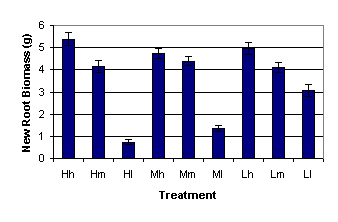
Figure 4. New root biomass of seedlings grown in the greenhouse for 12 weeks. Standard errors of the means are shown. (H, M, L=76%, 72%, 67% compaction respectively; h, m, l=high, medium, low water content respectively).
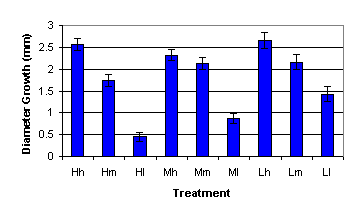
Figure 5. Diamter growth of seedlings grown in the greenhouse for 12 weeks. Standard errors of the means are shown. (H, M, L=76%, 72%, 67% compaction respectively; h, m, l=high, medium, low water content respectively).
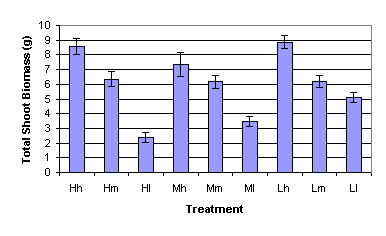
Figure 6. Total shoot biomass of seedlings grown in the greenhouse for 12 weeks. Standard errors of the means are shown. (H, M, L=76%, 72%, 67% compaction respectively; h, m, l=high, medium, low water content respectively).
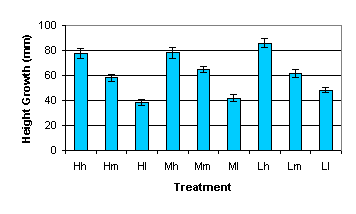
Figure 7. Height growth of seedlings grown in the greenhouse for 12 weeks. Standard errors of the means are shown. (H, M, L=76%, 72%, 67% compaction respectively; h, m, l=high, medium, low water content respectively).
Water content had a greater effect than compaction on seedling growth and biomass. New root biomass, diameter growth, total shoot biomass and height growth were all greatest for the high and medium water contents, regardless of compaction level. This effect of water content was also seen in a study by Prior et al. (1997) which showed that longleaf pine (Pinus palustrus Mill.) seedlings that experienced water stress were shorter and had smaller stem diameters compared to well-watered seedlings. A similar experiment by Rose et al. (1993) found that as soil water content decreased, growth of Douglas-Fir (Pseudotsuga menziesii) seedlings decreased, budbreak was delayed and needles were shorter.
Nutrient analysis of new foliage
Compaction only had an effect on the element concentrations of the new foliage of lodepole pine seedlings at low water content (Table 1). At low water content, concentrations of N and P were greater for 76% and 72% compaction treatments compared to 67% compaction treatment. At all compaction levels, severe to slight N deficiencies were detected in high to medium water contents, respectively and was likely due to slow rates of mineralization that occur in wet soils (Ballard and Carter 1986). Phosphorus was moderately deficient, as is expected when N is also deficient (Ballard and Carter 1986). Potassium concentration was greatest for 76% compaction compared to 67% compaction, but 72% compaction was intermediate to the other two levels. Potassium was found to be slightly deficient, which is common on acid, sandy loams with low organic matter (Ballard and Carter 1986). Calcium, Mg and S concentrations did not differ among compaction levels at low water content. The greater concentrations of elements in the 76% compaction treatments were likely due to a concentrating effect that was caused by the smaller biomass in these treatments.
Table 1. Concentration of nutrients for nine treatments of seedlings grown in the greenhouse for 12 weeks. Different letters within a column represent a significant difference between treatments.
Treatment |
|||||||
Compaction |
Water |
N |
P |
K |
Ca |
Mg |
S |
76% |
High |
10.5c |
0.73b |
4.6bc |
5.48abc |
2.38ab |
0.99bc |
72% |
High |
10.8c |
0.76b |
4.1c |
4.68abc |
2.34ab |
0.87c |
67% |
High |
10.7c |
0.75b |
4.4bc |
6.06ab |
2.48ab |
1.05bc |
76% |
Medium |
13.1bc |
0.71b |
3.5c |
5.59abc |
2.34ab |
0.97bc |
72% |
Medium |
15.5b |
0.92b |
4.8bc |
6.21a |
2.57a |
1.21ab |
67% |
Medium |
14.6b |
0.73b |
4.4bc |
5.96ab |
2.23ab |
1.00bc |
76% |
Low |
21.0a |
1.82a |
8.4a |
3.62c |
1.87b |
1.40a |
72% |
Low |
19.5a |
1.52a |
6.0b |
4.17bc |
2.11ab |
1.44a |
67% |
Low |
15.9b |
0.92b |
4.6bc |
5.53abc |
2.11ab |
1.78ab |
P value |
<0.0001 |
<0.0001 |
<0.0001 |
0.0008 |
0.02 |
<0.0001 | |
Conclusions
The interaction between water content and compaction levels was clearly illustrated in the differences in growth among the pine seedlings. Water stress had a much greater impact on seedling growth than did higher soil strengths imposed by greater bulk densities. Growth parameters such as new root biomass, stem diameter growth, total shoot biomass and stem height growth decreased as water stress increased for all compaction levels. When water content was low, greater soil strengths likely inhibited root growth. This in turn may have affected the shoot growth as well as the seedlings’ ability to acquire nutrients. High concentrations of nutrients in the 72% and 76% compaction treatments are likely due to a concentrating effect from the smaller biomass of seedlings in those treatments. Nitrogen deficiencies in the 76% compaction treatments may have had a growth limiting effect for the medium and high water content treatments.
The information obtained in this study is useful for managers attempting to efficiently carry out forest practices such as harvesting, while meeting environmental standards. The results show that, for the loamy soils we investigated, low and moderate levels of soil compaction can have a smaller impact on productivity than differences in water availability. These results are consistent with previous observations that growth limitation is not generally expected below relative bulk densities of about 80-85 % of Proctor. By placing the results of this study in context with similar studies being implemented on a variety of soil and site types, forest managers will be better able to predict the effect of machine traffic on forest productivity, and to identify and implement harvest systems that reduce costs while maintaining soil productivity.
References
American Society for Testing Materials (ASTM) (2000) Standard test methods for laboratory compaction characteristics of soil using standard effort (12,400 ft-lbf ft--3 (600 kN-m m-3)). Designation D 698–00a. ASTM, West Conshohocken, PA.
Ahuja LR, Fiedler F, Dunn GH, Benjamin JG (1998) Changes in soil water retention curves due to tillage and natural reconsolidation. Soil Science Society of America Journal 62, 1228-1233.
Ballard TM, Carter RE (1986) Evaluating forest stand nutrient status. Land Management Report Number 20. (Ministry of Forests: Victoria, BC).
BC Ministry of Forests (2001) Soil Conservation Guidebook, 2nd edition. Forest Practices Code of British Columbia Guidebook. (Ministry of Forests: Victoria, BC).
Bengough AG, Mullins CE (1990) Mechanical impedence to root growth: a review of experimental techniques and root growth responses. Journal of Soil Science 41, 341-358.
Buttery BR, Tan CS, Drury CF, Park SJ, Armstrong RJ, Park KY (1998) The effects of soil compaction, soil moisture and soil type on growth and nodulation of soybean and common bean. Canadian Journal of Plant Science 78, 571-576.
Conlin TSS, van den Driessche R (2000) Response of soil CO2 and O2 concentrations to forest soil compaction at the long-term soil productivity sites in central British Columbia. Canadian Journal of Soil Science 80, 625-632.
Corns IGW (1988) Compaction by forestry equipment and effects on coniferous seedling growth on four soils in the Alberta foothills. Canadian Jounal of Forest Research 18, 75-84.
Delta-T Devices (1999) Thetaprobe soil moisture sensor Type ML2x. User Manual. (Delta-T devices Ltd: Cambridge, England).
Ellies A, Horn R, Smith R, Gayoso J (1999) Effect of soil hydrological properties on changes in soil strength and stress distribution during forest clear cut. Z. f. Kulturtechnik und Landentwicklung 40, 169-173.
Froehlich HA (1988) Causes and effects of soil degradation due to timber harvesting. In ‘Degradation of forested land. 'Forest soils at risk’ (Eds JD Lousier, GW Still) pp. 3-12. (Research Branch, Ministry of Forests: Victoria, BC).
Froehlich HA, McNabb DH (1984) Minimizing soil compaction in Pacific Northwest forests. In ‘Forest Soils and Treatment Impacts’ (Ed EL Stone) pp. 159-192. (Department of Forestry, University of Tennessee: Knoxville, TN).
Greacen EL, Sands R (1980) Compaction of forest soils. A review. Australian Journal of Soil Research 18, 163-189.
Jordon D, Ponder Jr F, Hubbard VC (2003) Effects of soil compaction, forest leaf litter and nitrogen fertilizer on two oak species and microbial activity. Applied Soil Ecology 23, 33-41.
Kalra YP, Maynard DG (1991) Methods manual for forest soil and plant analysis. Rep. No. NOR-X-319. (Forestry Canada, Northwest Region, Northern Forestry Centre: Edmonton, Alberta).
McGill WB, Figueiredo CT (1993) Total Nitrogen. In ‘Soil Sampling and Methods of Analysis’ (Ed MR Carter ed) pp. 201-211. (Canadian Society of Soil Science, Lewis Publishers: Boca Raton, FL).
Prior SA, Runion GB, Mitchell RJ, Rogers HH, Amthor JS (1997) Effects of atmospheric CO2 on longleaf pine: productivity and allocation as influenced by nitrogen and water. Tree Physiology 17, 397-405.
Proctor RR (1933) Fundamental principles of soil compaction. Description of field and laboratory methods. Engineering News Record 111, 286-289.
Rockich DP, Meney KA, Dixon KW, Sivasithamparam K (2001) The impact of soil disturbance on root development in woodland communities in Western Australia. Australian Journal of Botany 49, 169-183.
Rose R, Gleason JF, Atkinson M (1993) Morphological and water-stress characteristics of three Douglas-fir stocktypes in relation to seedling performance under different soil moisture conditions. New Forests 7, 1-17.
Sands R, Bowen GD (1978) Compaction of Sandy soils in radiata pine forests 2. Effects of compaction on root configuration and growth of radiata pine seedlings. Australian Forest Research 8, 163-170.
Startsev AD, McNabb DH (2001) Skidder traffic effects on water retention, pore-size distribution, and van Genuchten parameters of boreal forest soils. Soil Science Society of America Journal 65, 224-231.
Unger PW, Kaspar TC (1994) Soil compaction and root growth: a review. Agronomy Jounal 86, 759-766.
Zabowski D, Rygiewicz PT, Skinner MF (1996) Site disturbance effects on a clay soil under radiata pine. Plant and Soil 186, 343-351.






